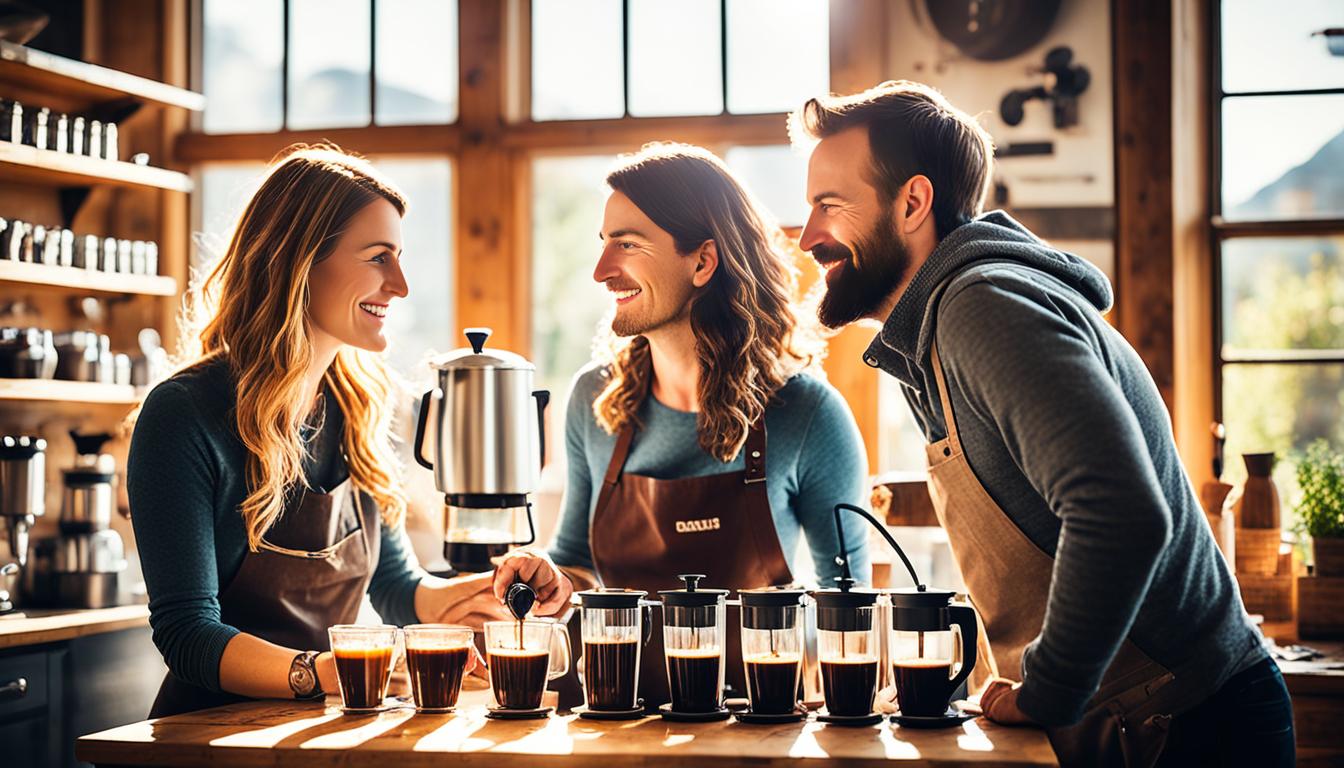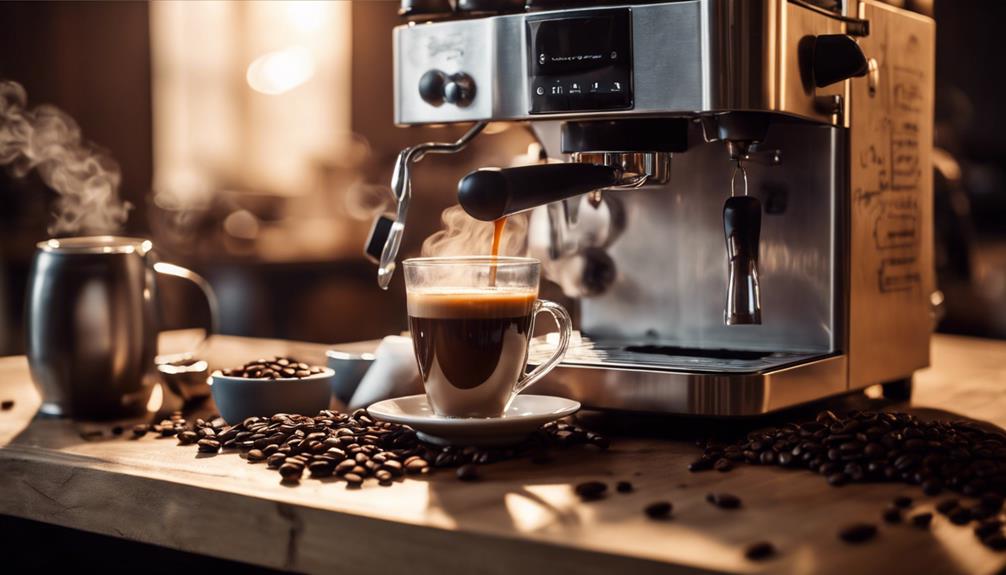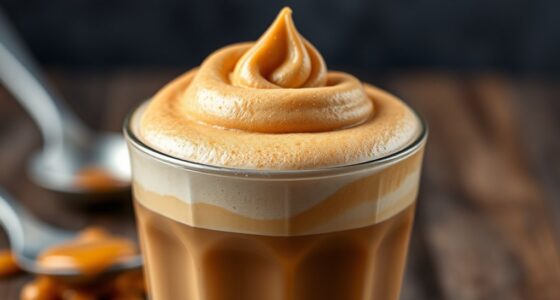Ever pondered on the distinctions between professional baristas and home coffee enthusiasts? The realm of being a barista goes beyond just brewing coffee; it entails grasping the complexities of beans and mastering diverse brewing methods. Coffee lovers devoted to home brewing understand that using top-notch beans, the right tools, and precise techniques can turn their coffee drinks into cafe-worthy creations. This article delves into a variety of exquisite coffee recipes that inspire DIY baristas to experiment and tailor each cup to their liking. From the frothy cappuccino to the decadent French Press, get ready to elevate your brewing skills with these delightful coffee recipes. To truly enhance your home brewing journey, it’s crucial to acquaint yourself with various coffee making techniques. Whether it’s perfecting the pour-over method or mastering the art of espresso extraction, comprehending the nuances of each brewing technique is essential for crafting exceptional coffee. By refining your skills in different brewing methods, you’ll be able to fine-tune each cup of coffee to perfection, just like a professional barista. So, roll up your sleeves, grab your favorite beans, and let’s embark on a journey through the realm of extraordinary coffee making techniques together.
Key Takeaways
- Understanding the complexities of coffee beans is crucial for crafting top-notch beverages at home.
- The right brewing techniques can elevate your home brewing to professional standards.
- High-quality ingredients and tools are essential for the best coffee experience.
- This guide includes a variety of popular and sophisticated coffee recipes to suit different tastes.
- Experimenting with and customizing your coffee preparation methods can lead to unique and satisfying results.
Introduction to Coffee Brewing Basics
Mastering the art of coffee brewing at home begins with understanding several key elements. Whether you’re a novice or an experienced home brewer, these fundamentals will help you cultivate a deeper appreciation for the process, ensuring that every cup you brew is as delightful as it is satisfying.
The Importance of Fresh Coffee Beans
One of the most crucial aspects of coffee brewing is the use of fresh beans. Freshly roasted beans such as Arabica, Robusta, and Liberica, impart unique flavor profiles that are essential for creating a high-quality brew. Using stale or old beans results in a lackluster cup of coffee, missing the nuances and richness fresh beans provide.
Different Grind Sizes for Different Methods
Another fundamental aspect is the grind size of the coffee beans. Different brewing methods require different grind sizes to optimize flavor extraction. For instance:
- Coarse Grind: Ideal for French Press and percolator methods.
- Medium Grind: Perfect for drip coffee makers and siphon brewers.
- Fine Grind: Suitable for espresso machines and AeroPress.
Choosing the right grind size according to your brewing method is critical for achieving the desired strength and taste in your coffee.
Water Quality and Temperature
The quality and temperature of the water used in coffee brewing is another vital factor. Using filtered water ensures that no impurities affect the coffee’s flavor. The ideal water temperature should be between 195 to 205 degrees Fahrenheit. Maintaining this range helps in extracting the optimal flavors from the beans while avoiding bitterness.
Understanding these basics will set a solid foundation for anyone looking to enhance their coffee brewing skills. With proper attention to fresh beans, appropriate grind sizes, and control over water quality and temperature, home baristas can replicate barista-level quality in their own kitchens.
Essential Tools for Brewing Like a Pro
For those aiming to master home brewing, precision brewing starts with investing in high-quality coffee equipment. By equipping your kitchen with the right tools, you can achieve consistency and exceptional flavor in every cup.
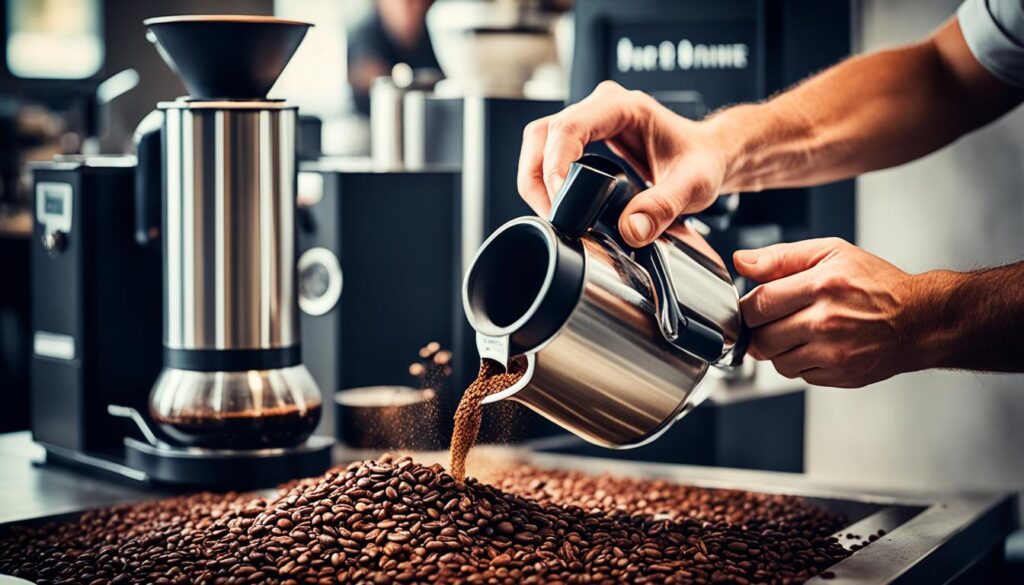
Quality Coffee Grinder
A quality grinder is indispensable for achieving the right grind size, which is critical for coffee extraction. Burr grinders, as opposed to blade grinders, provide a consistent grind, enhancing the flavor and ensuring an even brew. Brands like Baratza and Breville offer robust options that are popular among serious coffee aficionados.
Precision Kettle and Scale
A precision kettle, such as a gooseneck kettle, allows for accurate water temperature control, crucial for extracting the best flavors from your coffee beans. Coupling this with a digital scale ensures you use the perfect coffee-to-water ratio, essential for balancing strength and flavor. Hario and Fellow are renowned brands offering high-performing precision kettles and scales suited for home baristas.
Incorporating these key items into your coffee routine transforms the home brewing experience, enabling you to achieve professional-level results. These tools not only improve the quality of your coffee but also elevate the entire brewing process, making it more enjoyable and precise.
Cappuccino: A Classic Choice
A cappuccino is a timeless favorite among coffee lovers, prized for its perfect balance of rich espresso and velvety frothed milk. Creating the ideal cappuccino requires attention to detail and quality cappuccino ingredients.
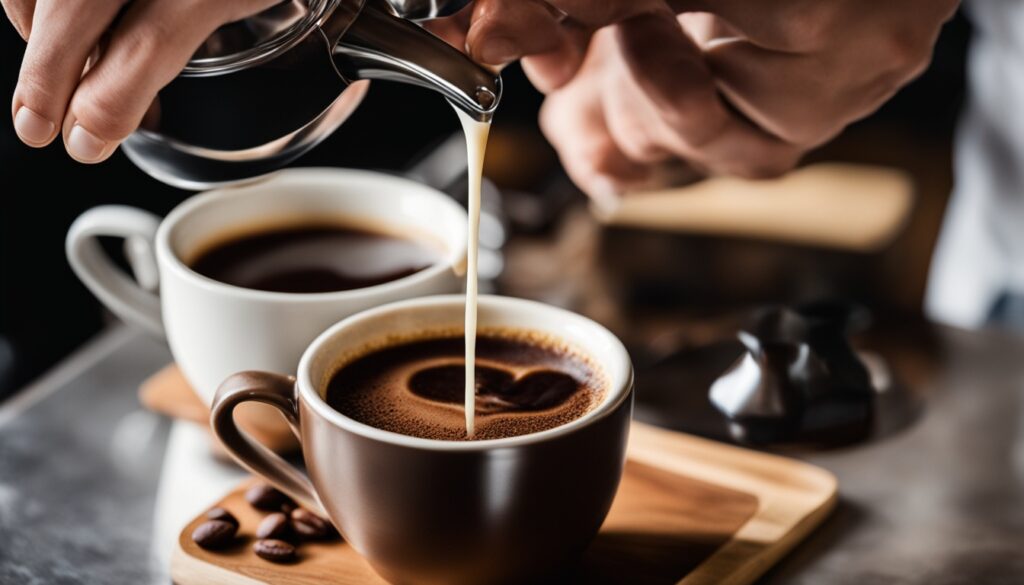
Ingredients Needed
To make a classic cappuccino, you will need:
- Freshly brewed espresso
- Whole milk or your preferred alternative
- Optional: sugar or sweetener to taste
Step-by-Step Instructions
- Brew the Espresso: Start by pulling a shot of espresso. Ensure your coffee is freshly ground, and tamp the grounds evenly for a balanced extraction.
- Steam the Milk: Using a steam wand, heat your milk until it reaches a velvety texture. The goal is to create frothed milk with a creamy and airy consistency.
- Combine Ingredients: Pour the hot espresso into a cup and gently layer the frothed milk over it. The foam should sit atop the cup, creating a visually appealing and taste-balanced beverage.
With these steps, anyone can master how to make a cappuccino at home, enjoying a rich interplay of flavors and textures.
Latte: Creamy Perfection
The latte stands out among coffee drinks for its smooth and creamy texture, achieved through the perfect blending of espresso and steamed milk. A delightful treat for coffee aficionados, this latte recipe requires special attention to detail to create an impeccable beverage.
Begin by brewing a rich shot of espresso, ensuring that it is neither too bitter nor too weak. The quality of the espresso significantly influences the overall flavor of the latte. Use freshly ground beans and a precise brewing method to capture the essence of the coffee.

Next, focus on steaming the milk to create a creamy and velvety texture. The milk should be heated to around 150-155 degrees Fahrenheit, just below boiling, to achieve the ideal consistency. Properly steamed milk should have microfoam—tiny bubbles that create a smooth and luscious mouthfeel. The art of steaming milk can take some practice, but it is a crucial step in making the perfect latte.
Combine the freshly brewed espresso with the steamed milk, pouring the milk slowly to create a harmonious blend. Finally, add a delicate layer of milk foam on top to complete the beverage. This frothy cap not only enhances the visual appeal but also adds to the creaminess of the latte, making it a quintessential coffee drink.
Mastering this latte recipe allows home baristas to enjoy a decadent, café-quality coffee drink in the comfort of their own home. The combination of rich espresso, perfectly steamed milk, and the elegant milk foam promises a sublime coffee experience.
Whether serving guests or enjoying a quiet moment alone, crafting the ideal latte is a ritual that celebrates the art of coffee making. By following these steps, anyone can achieve the creamy perfection that defines this beloved coffee drink.
Mocha: A Chocolate Lover’s Delight
The mocha is a luxurious coffee beverage that seamlessly blends the boldness of espresso with the sweetness of chocolate syrup and the creaminess of steamed milk. It’s a favorite among those who crave a rich, decadent treat that harmonizes coffee and chocolate flavors.
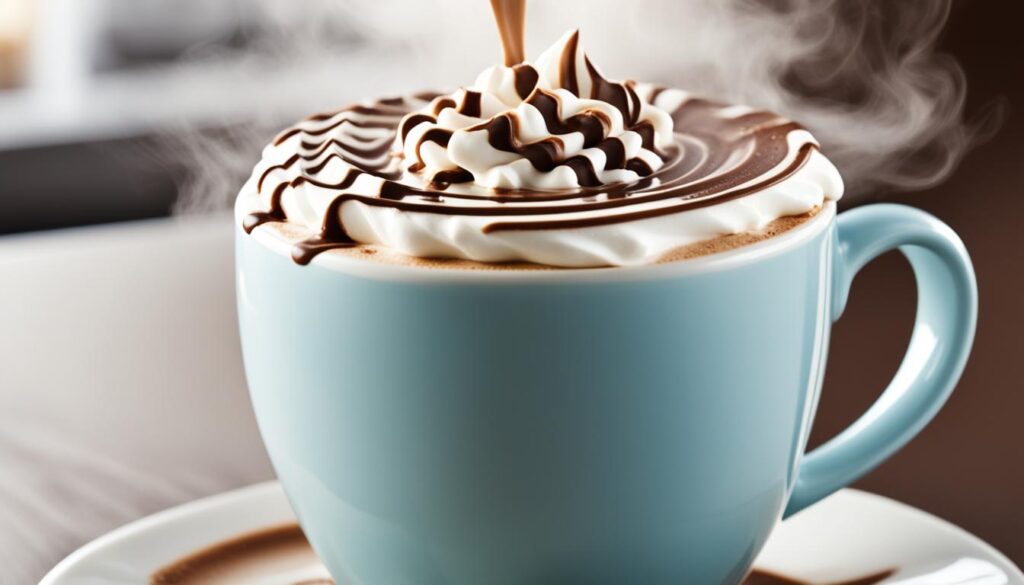
Ingredients and Tools Needed
- 1 shot of espresso
- 2 tablespoons of chocolate syrup
- 1 cup of steamed milk
- Whipped cream (optional)
- Cocoa powder (optional)
- Coffee mug
- Espresso machine or alternative brewing method
Preparation Steps
- Brew a fresh shot of espresso using a high-quality coffee bean of your choice.
- In your coffee mug, add the chocolate syrup, followed by the freshly brewed espresso. Stir well to ensure the chocolate syrup is fully dissolved.
- Steam the milk to a velvety smooth texture, making sure it is hot but not boiling.
- Pour the steamed milk into the coffee mug, combining it with the chocolate-infused espresso. Be gentle to maintain the creaminess of the milk.
- For an added touch of indulgence, top your mocha with whipped cream and a light dusting of cocoa powder.
This mocha recipe provides a delightful balance of flavors, perfect for indulging in a cozy, chocolaty caffeine fix. Ideal for home baristas, each step ensures a seamless experience in crafting this luxurious beverage, making it both a rewarding and delicious endeavor.
Americano: Simple Yet Bold
The Americano coffee offers a straightforward yet profound experience, making it a favorite choice for many coffee aficionados. This beverage is crafted by simply adding hot water to a robust shot of espresso, which dilutes the strength without compromising the rich flavors.
The beauty of the Americano lies in the balance between espresso and hot water. To perfect this drink, baristas often adjust the ratio to suit individual preferences, typically using 1 to 2 shots of espresso for a standard cup. By tweaking the amount of hot water, they can either highlight or mellow the distinctive complexities of the espresso.

Understanding how to achieve the optimal balance is key in making a remarkable Americano. The following table outlines different ratios and their resulting taste profiles:
| Ratio (Espresso to Hot Water) | Taste Profile |
|---|---|
| 1:1 | Strong and intense, retaining the boldness of the espresso. |
| 1:2 | Balanced with a deep flavor, allowing for a more approachable drink. |
| 1:3 | Smoother with a subtle espresso undertone, perfect for those preferring a lighter taste. |
Whether you prefer a strong, intense cup or a smoother, more diluted experience, the Americano can be tailored precisely to your taste. By experimenting with different ratios, every coffee enthusiast can discover their perfect blend, celebrating the inherent qualities of the espresso while enjoying a drink that’s uniquely theirs.
Macchiato: Espresso with a Twist
The macchiato, a quintessential Italian espresso drink, is known for its bold, rich flavors complemented by a hint of frothy milk. Perfect for those who love a strong, aromatic coffee with a creamy touch, the macchiato has become a beloved favorite among coffee enthusiasts.
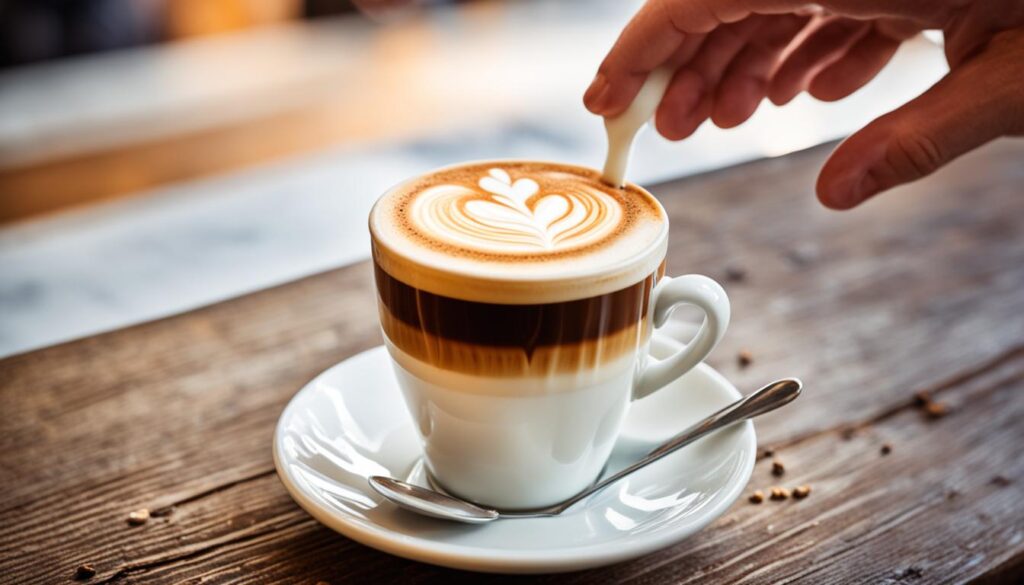
Ingredients Required
Crafting the perfect espresso macchiato begins with choosing the right ingredients. Here’s a simple list to get you started:
- 1 shot of freshly brewed espresso
- A small amount of frothy milk
How to Make It
Follow these easy steps to prepare a delightful macchiato:
- Brew the espresso: Start by brewing a fresh shot of espresso using high-quality coffee beans. The rich, concentrated flavor of the espresso is the heart of the macchiato guide.
- Prepare the frothy milk: Froth a small amount of milk until it achieves a creamy, airy consistency. This step is crucial as the frothy milk enhances the overall texture and taste.
- Combine: Pour the espresso into a small cup, then delicately spoon a dollop of the frothy milk on top. The result is a harmonious blend where the boldness of the espresso meets the silky smoothness of the milk.
Enjoy your expertly crafted espresso macchiato, appreciating the nuanced balance that this classic beverage offers. Whether starting your day or savoring a mid-afternoon pick-me-up, the macchiato is sure to impress with its distinctive and invigorating flavors.
Flat White: A Barista Favorite
The flat white coffee has quickly become a favorite for many coffee lovers, appreciated for its robust flavor and smooth texture. Combining a rich espresso base with a layer of velvety milk, it stands out not just for its taste but also for its aesthetic appeal, often enhanced by intricate latte art.
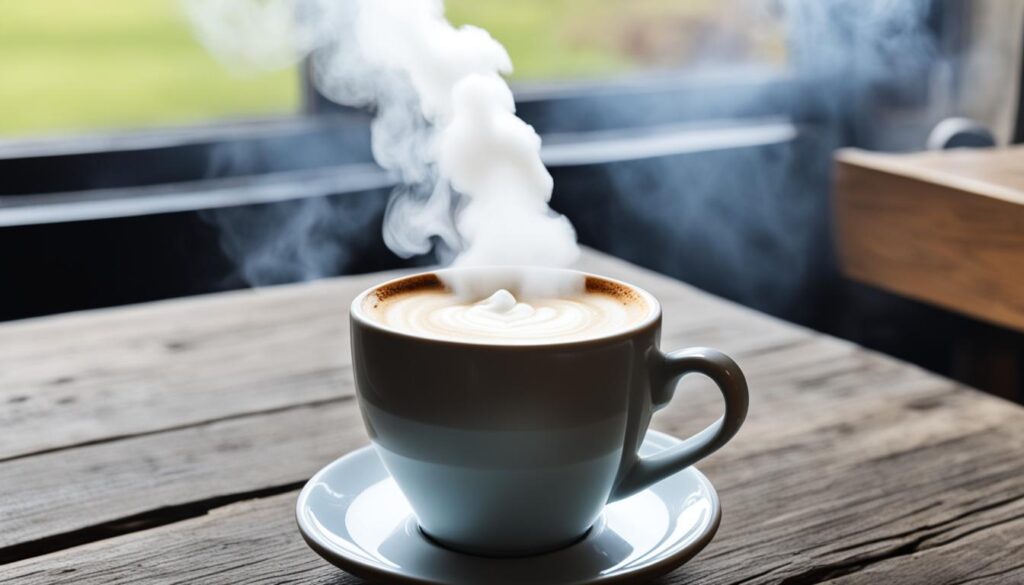
The secret to a perfect flat white lies in the technique of blending the espresso with the velvety milk. Here, the microfoam is key—a fine-textured milk foam that gives the flat white its signature smoothness. Achieving this consistency requires precise steaming and pouring, skills that any aspiring home barista can master with practice.
“The flat white offers a balanced, harmonious coffee experience, making it an ideal canvas for those who enjoy the artistry of latte art.”
Olivia – Expert Barista
- Begin with a double shot of espresso, ensuring it is brewed to perfection.
- Steam the milk to create a velvety microfoam, aiming for a texture that is smooth and cohesive.
- Pour the steamed milk over the espresso, allowing the two components to meld seamlessly.
The flat white coffee not only satisfies the palate but also provides an opportunity for creative expression through latte art. The dense microfoam is ideal for crafting intricate patterns and designs, elevating the coffee-drinking experience from the very first sip.
| Component | Ideal Characteristics | Impact on Final Drink |
|---|---|---|
| Espresso | Rich, bold flavor | Forms the robust base |
| Microfoam Milk | Velvety texture | Provides smoothness and enhances latte art |
Espresso: The Heart of Many Coffee Recipes
Espresso, quintessential to a myriad of cherished coffee beverages, is revered for its potent flavor and distinctive rich crema on top. Successfully brewing a quality espresso demands a meticulous approach to coffee brewing, involving precise grinding, dosing, and extraction under high pressure. This concentrated shot forms the backbone of numerous coffee creations.
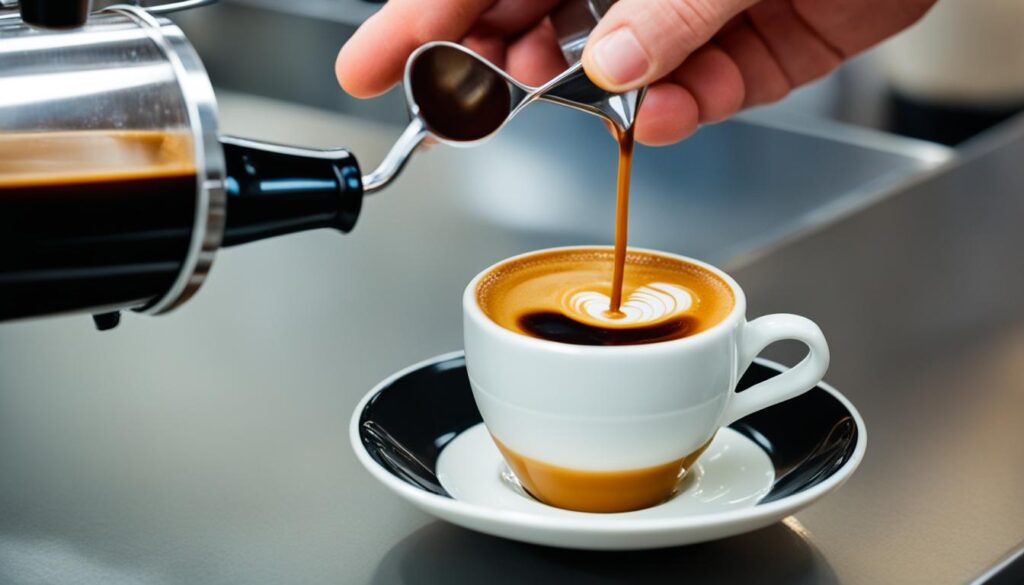
Understanding the espresso basics begins with selecting the right beans. Freshly roasted beans play a critical role in crafting the perfect quality espresso. The grind size must be fine and consistent to ensure even extraction, contributing to the depth of flavor and the iconic rich crema.
The coffee-to-water ratio and the pressure applied during extraction are key factors in achieving the optimal espresso. Enthusiasts often experiment with different parameters to discover their perfect brew, tailored to their taste preferences. This precision in coffee brewing elevates the espresso experience, making it a true art form that coffee lovers continue to master.
Affogato: Coffee Meets Ice Cream
The affogato is an exquisite Italian dessert that seamlessly combines the bold flavors of espresso with the creamy, luxurious texture of vanilla ice cream. Originating from Italy, this dessert translates to “drowned” in English, aptly named as it features a scoop of vanilla ice cream “drowned” in freshly brewed espresso.
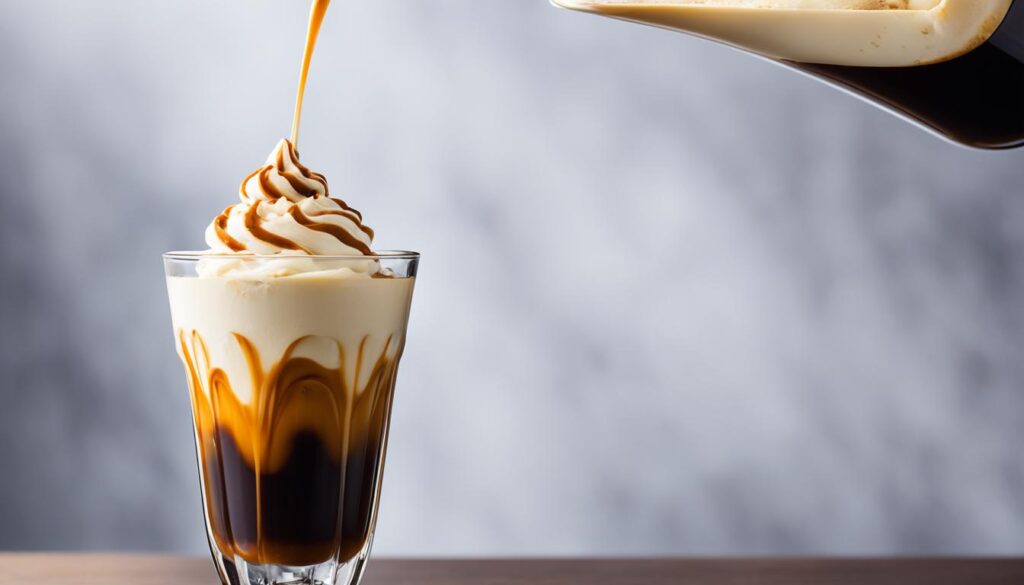
To prepare this delightful treat, simply place a scoop of vanilla ice cream in a small dish or glass. Pour a shot of hot espresso over the ice cream and serve immediately. The hot espresso begins to melt the ice cream, creating a harmonious blend of warm and cold, and a flavor profile that is indulgent and satisfying.
The beauty of the affogato lies in its simplicity and the quality of its ingredients. Ensuring that you use the finest, creamiest vanilla ice cream and a robust shot of espresso is key to achieving the perfect balance of flavors in this dessert. Additionally, variations can be experimented with, such as adding a splash of liqueur like Amaretto or Frangelico for an adult twist.
Whether enjoyed as a dessert after dinner or as an afternoon treat, the affogato offers a quick and easy way to impress guests and satisfy your sweet tooth. This effortless yet elegant combination of espresso and vanilla ice cream is sure to become a favorite in your repertoire of coffee-based desserts.
Irish Coffee: A Spiked Treat
Irish Coffee is an exquisite blend that marries the warming essence of coffee with the robustness of Irish whiskey. This classic beverage is further enhanced with brown sugar and topped with a creamy layer of whipped cream, making it a delightful treat.
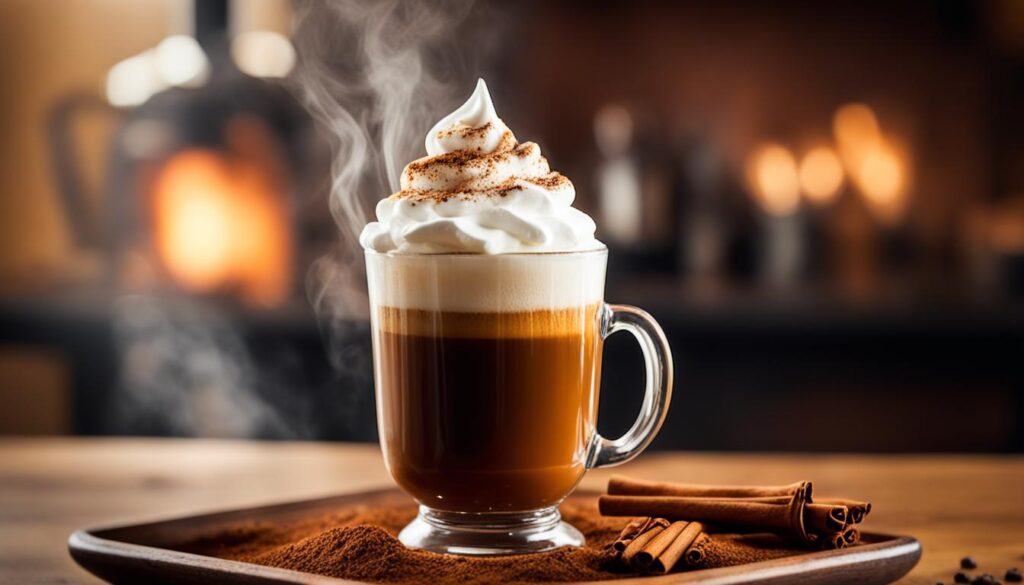
Recipe Ingredients
- 4 oz hot coffee
- 1 1/2 oz Irish whiskey
- 1-2 teaspoons brown sugar
- Heavy whipped cream
Preparation and Serving Tips
- Pre-warm a glass mug by filling it with hot water. Discard the water after the mug is warm.
- Add the brown sugar into the warmed mug and pour in hot coffee. Stir until the sugar is fully dissolved.
- Pour the Irish whiskey into the coffee and stir lightly.
- Spoon a thick layer of whipped cream over the top, allowing it to float on the coffee.
When preparing the Irish Coffee recipe, balance is key to achieving a harmonious flavor profile. The rich aroma of the Irish whiskey should complement, not overpower, the coffee’s warmth, while the luxurious whipped cream provides the perfect finishing touch. Serve in a clear glass mug to showcase the beverage’s beautiful layered presentation.
Vietnamese Iced Coffee: A Refreshing Twist
Vietnamese Iced Coffee, or cà phê đá, exemplifies a deeply rooted coffee culture that balances intensity and refreshment. This delightful beverage is renowned for its use of *robust coffee* paired perfectly with *sweetened condensed milk*, creating an invigorating drink served over ice. Below, we explore the essential ingredients and share the step-by-step brewing process to help you craft this exceptional drink at home.
Essential Ingredients
To make the authentic *Vietnamese iced coffee*, you’ll need the following ingredients:
- Robust dark roast coffee
- Sweetened condensed milk
- Hot water
- Ice cubes
- Traditional Vietnamese coffee filter (phin)
Brewing Process
The brewing process for *Vietnamese iced coffee* is both simple and unique, enhancing the robust flavors of the coffee. Follow these steps:
- Preheat the phin filter by pouring hot water through it and discarding the water after a few seconds.
- Place the phin filter over a glass or cup, then add 2-3 tablespoons of ground *robust coffee* into the filter. Gently press the coffee grounds with the filter’s gravity insert.
- Add sweetened condensed milk to the bottom of a glass—approximately 2-3 tablespoons, depending on your preferred sweetness.
- Next, pour about an ounce of hot water into the filter to allow the coffee grounds to bloom for 20-30 seconds. After blooming, add the remaining hot water (about 4 ounces) and cover the filter.
- Allow the coffee to drip slowly (this may take 5-7 minutes) into the glass containing the sweetened condensed milk.
- Once all the coffee has dripped through, stir the mixture thoroughly to combine the *robust coffee* with the *sweetened condensed milk*.
- Pour the mixture over a glass filled with ice cubes and serve immediately.

This brewing method enhances the unique qualities of the *Vietnamese iced coffee*, delivering a refreshing drink that combines the boldness of *robust coffee* with the creamy sweetness of *sweetened condensed milk*. Embark on a sensory journey to Vietnam with κάθε sip.
Best Coffee Recipes for a Home Barista
For those embarking on their home barista journey, experimenting with a variety of coffee recipes offers an exciting flavor exploration. From the aromatic cappuccino to the indulgent mocha, each recipe employs unique coffee techniques to create distinct profiles.
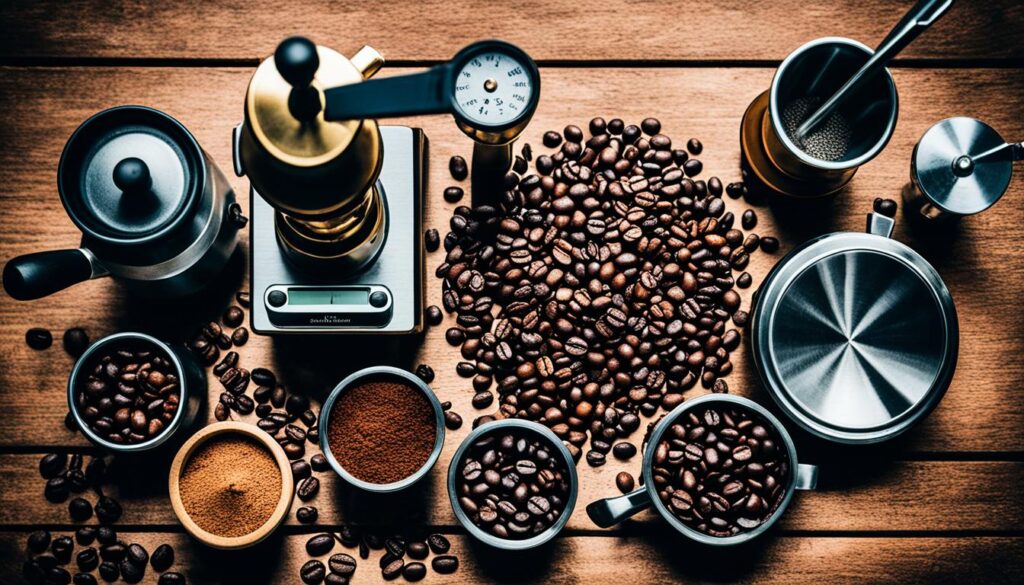
Delving deeper into the home barista recipes provided earlier, it becomes clear that mastering different coffee techniques can significantly enhance one’s brewing skills. Utilizing tools like the French Press, Chemex, and AeroPress not only diversifies your coffee-making arsenal but also broadens your understanding of the flavors each method can bring out.
Incorporating insights from our previous sections, let’s revisit some key elements:
- Understanding coffee techniques such as precise water temperature, grind sizes, and the quality of fresh beans
- Exploring different recipes like the velvety latte and the bold Americano for a comprehensive flavor exploration
- Utilizing essential tools like quality grinders, precision kettles, and scales to ensure each coffee drink meets professional standards
By consistently practicing these coffee techniques, a home barista can advance from basic recipes to intricate styles, continually refining their craft and discovering new layers of flavor in every cup. This multifaceted approach to home barista recipes sets the stage for a never-ending journey of coffee enjoyment and expertise.
French Press Coffee: Rich and Full-Bodied
French Press coffee is renowned for its rich coffee flavor profile and full-bodied texture, making it a favorite among coffee enthusiasts. The French Press method is appreciated not only for its simplicity but also for the way it extracts all the essential oils and fine particles that create a deep and satisfying cup of coffee.
Before diving into the French Press method, it is crucial to have the necessary ingredients and tools prepared to achieve the best results.
Required Ingredients and Tools
To successfully brew with the French Press method, you’ll need the following:
- French Press
- Coarsely ground coffee (ideally medium to dark roast)
- Filtered water heated to 200 degrees Fahrenheit
- Stirring utensil (wooden or plastic recommended)
- Timer
The key to a rich coffee experience lies in the grind size. For the French Press, always use coarsely ground coffee to prevent sediment from seeping into the beverage and ensure an even extraction.
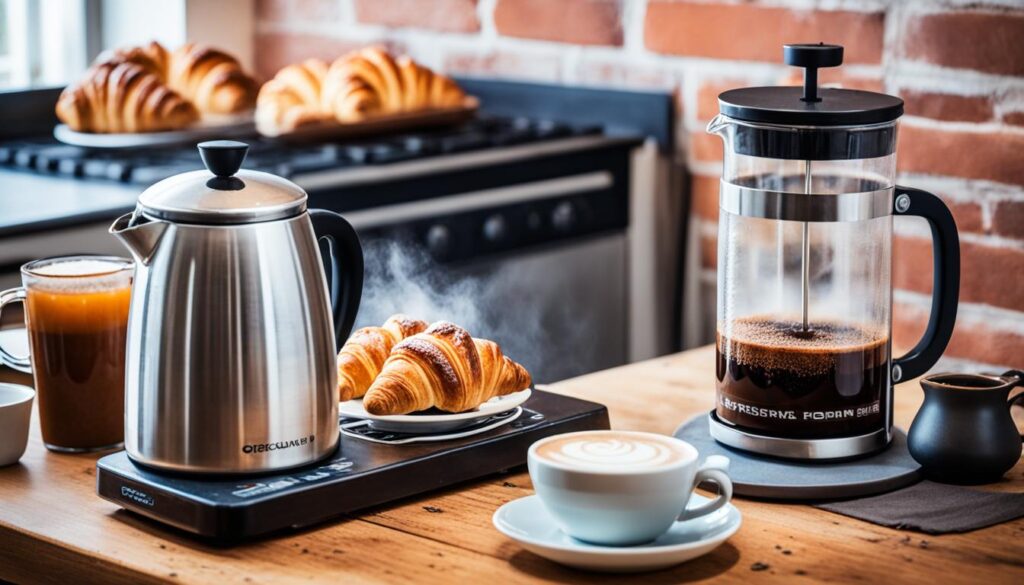
Step-by-Step Brewing Instructions
- Preheat the French Press: Pour hot water into the French Press, swirl it around, and discard. This step warms up the device and helps maintain the brew temperature.
- Add Coffee Grounds: Place the coarsely ground coffee into the French Press. Use a ratio of about 1 ounce (28 grams) of coffee to 12 ounces (355 milliliters) of water, but you can adjust according to your preference.
- Add Water: Pour the filtered hot water over the coffee grounds, ensuring all the grounds are saturated. Stir gently.
- Steep: Place the lid on the French Press without pressing the plunger down. Let the coffee steep for about 4 minutes for a rich coffee brew.
- Plunge and Serve: Press the plunger down slowly and evenly, then pour your coffee immediately to avoid over-extraction.
Chemex: A Clean, Flavorful Brew
The Chemex is more than just an aesthetically pleasing coffee maker; it is designed to provide a unique pour-over coffee experience that appeals to specialty coffee enthusiasts. Chemex brewing utilizes thick, proprietary filters that remove oils and grounds, resulting in a clean, crisp cup that accentuates intricate flavors often missed with other brewing methods.
The design of the Chemex is purposeful and iconic, with its hourglass shape and wooden collar providing both function and form. When performing a pour-over coffee routine, the Chemex’s special filters play a vital role in ensuring a sediment-free brew. This method requires a controlled pour and the right grind size to unlock the potential of the chosen specialty coffee beans.
The elegance of the Chemex lies in its simplicity and effectiveness. The process involves soaking the grounds, a steady slow pour, and allowing gravity to do the rest, rewarding you with an exceptionally clean and bright coffee.
- The filters: Thick, specialty Chemex filters remove unwanted particles and oils.
- The process: Involves precise coffee-to-water ratio and a steady hand for the pour-over.
- The result: A pure, flavor-rich brew that enhances the subtleties of specialty coffee.
For coffee aficionados, mastering Chemex brewing allows an exploration into the true character of their coffee, transforming a simple morning routine into a delightful culinary experience. By understanding and practicing this method, one can achieve a level of clarity and depth in their coffee that matches the precision and artistry of professional baristas.
| Feature | Chemex | Other Pour-Over Methods |
|---|---|---|
| Filter Thickness | Thick | Varies |
| Flavor Clarity | High | Moderate to High |
| Ease of Use | Moderate | Easy to Moderate |
| Design Aesthetic | Iconic | Varies |
AeroPress: Versatile and Quick

The AeroPress technique has gained popularity among coffee aficionados for its versatility and efficiency. By combining immersion and pressure, this method allows for a full-flavored coffee brew in under two minutes.
The AeroPress is designed for convenience, making it an ideal choice for those who value both speed and quality in their daily coffee pressing routine. Unlike traditional brewing methods, the AeroPress is portable, easy to clean, and remarkably flexible in terms of coffee-to-water ratio and grind size.
Here are some steps to perfect your AeroPress technique:
- Start by heating water to around 175-185°F. This temperature range ensures optimal extraction without scorching the coffee.
- Grind your coffee beans to a medium-fine consistency. The grind size impacts the extraction process, so it’s essential to find the right balance.
- Assemble your AeroPress by placing a filter in the cap and securing it to the chamber.
- Add your medium-fine ground coffee into the chamber, using about 2 tablespoons for a single serving.
- Pour hot water over the grounds until they are fully immersed. Stir gently to ensure even saturation.
- Attach the plunger and press down slowly, applying steady pressure for about 30 seconds.
- Enjoy your freshly brewed, full-flavored coffee, either as a concentrated shot or diluted to Americano strength.
To further refine your coffee pressing experience, consider experimenting with different coffee-to-water ratios, grind sizes, and brew times. The AeroPress allows for endless possibilities, letting home baristas create a cup of coffee that can easily rival any gourmet cafe option.
Ultimately, mastering the AeroPress technique provides coffee lovers with a quick, versatile, and highly customizable way to enjoy a full-flavored coffee at home or on the go.
Conclusion
Embarking on the coffee journey outlined in this article allows home baristas to elevate their brewing skills to new heights. From understanding the importance of fresh coffee beans to mastering techniques with tools like the French Press and AeroPress, readers are now equipped with the knowledge needed to create delightful, high-quality coffee beverages at home.
This comprehensive exploration into various coffee recipes and brewing methods showcases the artistry and science behind each cup. As readers dive into recipes like the indulgent mocha or the refreshing Vietnamese iced coffee, they can appreciate the diversity and depth of flavors that careful brewing artistry brings to the table.
Ultimately, the goal for any home barista is to enjoy coffee through continuous experimentation and refinement. By embracing the role of a home-based coffee connoisseur, readers not only enhance their daily coffee routines but also gain a deeper appreciation for the craft of brewing. The techniques and insights shared in this article serve as a lasting resource, inspiring ongoing passion and mastery in the world of home-brewed coffee.
